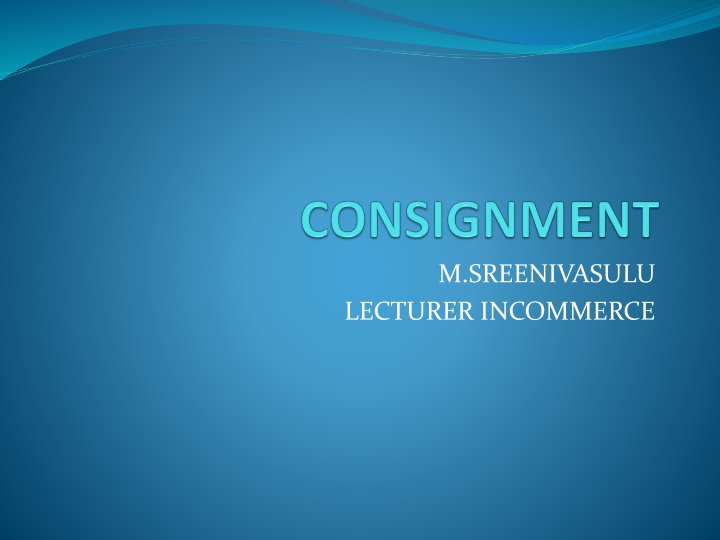
Understanding Consignment Agreements in Commerce
Explore the concept of consignment in commerce, where goods are entrusted to a consignee for sale while legal ownership remains with the consignor. Learn about the transfer of possession, responsibilities of the parties involved, and how revenue recognition is impacted in consignment arrangements.
Download Presentation

Please find below an Image/Link to download the presentation.
The content on the website is provided AS IS for your information and personal use only. It may not be sold, licensed, or shared on other websites without obtaining consent from the author. If you encounter any issues during the download, it is possible that the publisher has removed the file from their server.
You are allowed to download the files provided on this website for personal or commercial use, subject to the condition that they are used lawfully. All files are the property of their respective owners.
The content on the website is provided AS IS for your information and personal use only. It may not be sold, licensed, or shared on other websites without obtaining consent from the author.
E N D
Presentation Transcript
M.SREENIVASULU LECTURER INCOMMERCE
Consignment is the act of consigning, the act of giving over to another person or agent's charge, custody or care any material or goods but retaining legal ownership until the material or goods are sold. That may be done for the purpose of shipping the goods, transferring the goods to auction or intending the goods to be placed on sale in a store (a consignment store). The verb "consign" means "to send" and therefore the noun "consignment" means "sending goods to another person". In the case of "retail consignment" or "sales consignment" (often just referred to as a "consignment"), goods are sent to the agent for the purpose of sale. The ownership of these goods remains with the sender. The agent sells the goods on behalf of the sender according to instructions. The sender of goods is known as the "consignor" and the agent entrusted with the custody and care of the goods is known as the "consignee".
In consignment agreement the possession of goods transfer from one party to another. The relation between the two parties is that of consignorand consignee, not that of buyer and seller. The consignor is entitled to receive all the expenses in connection with consignment. The consignee is not responsible for damage of goods during transport or any other procedure. Goods are sold at the risk of the consignor with profit or loss belonging to the consignor only. A consignor who consigns goods to a consignee transfers only possession, not ownership, of the goods to the consignee. The consignor retains title to the goods. The consignee takes possession of the goods subject to a trust. If the consignee converts the goods to a use not contemplated in the consignment agreement, such as by selling them and keeping the proceeds of the sale for the consignee, the crime of conversion has been committed. The word consignment comes from the French consigner, meaning "to hand over or transmit", originally from the Latin consignor "to affix a seal", as it was done with official documents just before being sent. in return for the service of consignee, commission is paid to him by Consignor
When a vendor (consignor) provides goods on consignment to a distributor (consignee) then revenue cannot be recognized when control has transferred. This could occur at the expiration of a specified consignment period, or the sale of an item to an end-consumer. The SEC has provided examples of consignment arrangements in question 2 of SAB Topic 13.A.2 including the following: A customer's obligation to pay is implicitly excused until consumption or sale The seller has an obligation to bring about resale A repurchase price exists that will be adjusted for holding costs and interest Accounting Standards Codification (ASC) 606-10-55-80 (implemented for public companies December 15, 2017) provides three indicators of the presence of consignment arrangement that provides the principles behind the examples that the SEC has outlined. These indicators are as follows: The vendor controls the product until a specified event occurs, such as the sale to an end-customer, or until a specified period expires. The vendor is able to require the return of the product or transfer of the product to a third party. The consignee does not have an unconditional obligation to pay for the product (although it may be required pay a deposit). This list of indicators of a consignment arrangement is not all-inclusive, so companies should also consider other indicators of the transfer of control found in ASC 606-10-25-30.[
In the 21st century, so-called consignment shops have become trendy, especially those offering specialty products, infant wear, pet care, and high-end fashion items. The millennial generation, in particular, is known for its frugal shopping habits, which include eschewing high-end stores and designer boutiques in favor of bargains found at thrift and consignment shops. Economists list rising student debt, stagnant wages and the psychological effects of the Great Recession of 2007-2009 as factors pushing younger shoppers toward consignment shops and other discount stores.
Selling on consignment is a great option for an individual or business that does not have a brick-and-mortar presence, although consignment arrangements can also exist in cyberspace. To a certain degree, online companies such as eBay are consignment shops; for a percentage of the sale, they offer people a marketplace to exhibit and sell their wares. Likewise, items marketed and sold through television channels such as the as-seen-on-TV phenomenon are forms of consignment. Sellers who do not have the time or the desire to advertise their product for sale, to take time off work to accommodate prospective buyers' schedules, to conduct pricing research, and to endure the tasks associated with selling an item firsthand often find that consignment fees are a small price to pay to put the work in someone else's hands, particularly if they are successful in negotiating a low fee.
